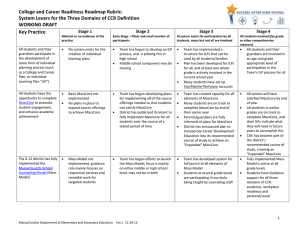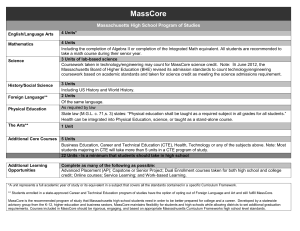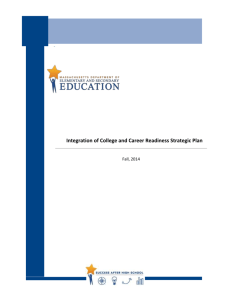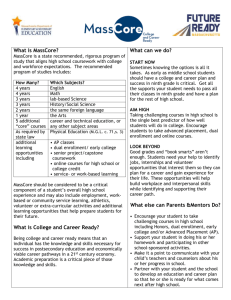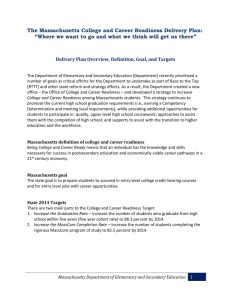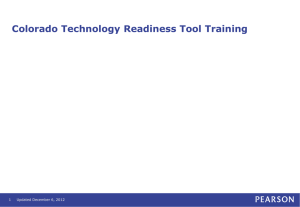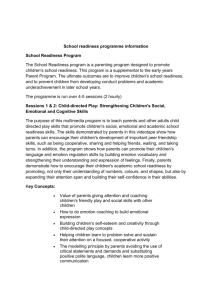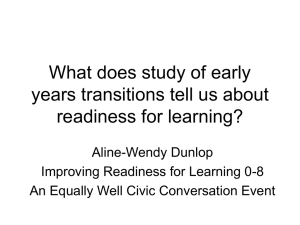CCR Roadmap Rubric - Massachusetts Department of Education
advertisement
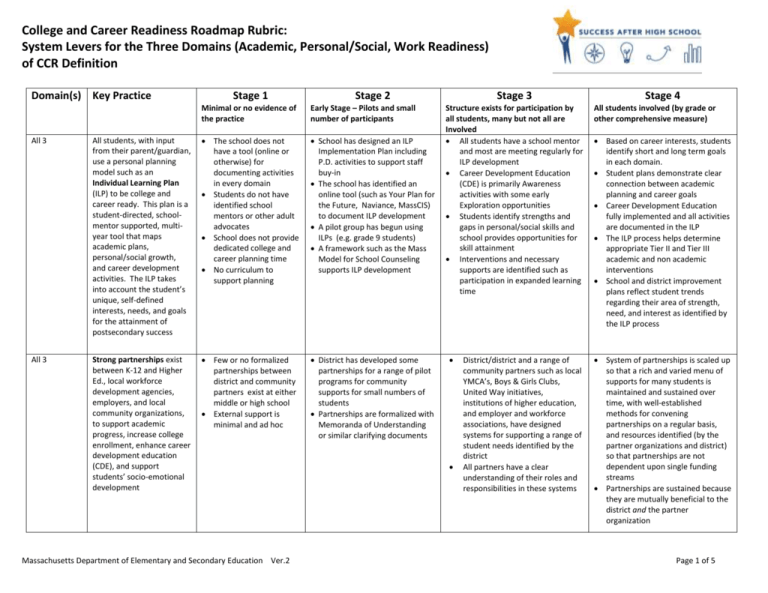
College and Career Readiness Roadmap Rubric: System Levers for the Three Domains (Academic, Personal/Social, Work Readiness) of CCR Definition Domain(s) Key Practice Stage 1 Stage 2 Minimal or no evidence of the practice Early Stage – Pilots and small number of participants All 3 All students, with input from their parent/guardian, use a personal planning model such as an Individual Learning Plan (ILP) to be college and career ready. This plan is a student-directed, schoolmentor supported, multiyear tool that maps academic plans, personal/social growth, and career development activities. The ILP takes into account the student’s unique, self-defined interests, needs, and goals for the attainment of postsecondary success The school does not have a tool (online or otherwise) for documenting activities in every domain Students do not have identified school mentors or other adult advocates School does not provide dedicated college and career planning time No curriculum to support planning School has designed an ILP Implementation Plan including P.D. activities to support staff buy-in The school has identified an online tool (such as Your Plan for the Future, Naviance, MassCIS) to document ILP development A pilot group has begun using ILPs (e.g. grade 9 students) A framework such as the Mass Model for School Counseling supports ILP development All 3 Strong partnerships exist between K-12 and Higher Ed., local workforce development agencies, employers, and local community organizations, to support academic progress, increase college enrollment, enhance career development education (CDE), and support students’ socio-emotional development Few or no formalized partnerships between district and community partners exist at either middle or high school External support is minimal and ad hoc District has developed some partnerships for a range of pilot programs for community supports for small numbers of students Partnerships are formalized with Memoranda of Understanding or similar clarifying documents Massachusetts Department of Elementary and Secondary Education Ver.2 Stage 3 Structure exists for participation by all students, many but not all are Involved All students have a school mentor and most are meeting regularly for ILP development Career Development Education (CDE) is primarily Awareness activities with some early Exploration opportunities Students identify strengths and gaps in personal/social skills and school provides opportunities for skill attainment Interventions and necessary supports are identified such as participation in expanded learning time District/district and a range of community partners such as local YMCA’s, Boys & Girls Clubs, United Way initiatives, institutions of higher education, and employer and workforce associations, have designed systems for supporting a range of student needs identified by the district All partners have a clear understanding of their roles and responsibilities in these systems Stage 4 All students involved (by grade or other comprehensive measure) Based on career interests, students identify short and long term goals in each domain. Student plans demonstrate clear connection between academic planning and career goals Career Development Education fully implemented and all activities are documented in the ILP The ILP process helps determine appropriate Tier II and Tier III academic and non academic interventions School and district improvement plans reflect student trends regarding their area of strength, need, and interest as identified by the ILP process System of partnerships is scaled up so that a rich and varied menu of supports for many students is maintained and sustained over time, with well-established methods for convening partnerships on a regular basis, and resources identified (by the partner organizations and district) so that partnerships are not dependent upon single funding streams Partnerships are sustained because they are mutually beneficial to the district and the partner organization Page 1 of 5 College and Career Readiness Roadmap Rubric: System Levers for the Three Domains (Academic, Personal/Social, Work Readiness) of CCR Definition All 3 All 3 All 3 The K-12 district has fully implemented a strong guidance model to serve all students, e.g. the Massachusetts School Counseling Model (Mass Model) Mass Model or other holistic guidance model not implemented, guidance role mainly focuses on responsive services and remedial work for targeted students District has begun efforts to launch the Mass Model or other holistic guidance model, focus is mainly on either middle or high school level, may not be in both There are well-designed linkages between secondary and postsecondary systems that assist students’ transition from one to the next Few or no linkages exist between district(s) and higher education partners in the region and state Modest amount of dual enrollment takes place, typically for students with higher skills looking for courses not offered in their high schools Districts and higher education partners are working together to design transition programs for students moving from secondary to postsecondary education Pilot use of articulation agreements and more systemic use of Dual Enrollment begun Pilot use of early college designs, using models such as Gateway to College and Pathways to Prosperity Expanded learning time (including through partner organizations) is a possibility for all students and learning that occurs outside the classroom and the regular school day is available. District and community partners offer minimal opportunities for expanded learning time District and partners are piloting programs for students to participate in expanded learning time in non-traditional settings Small numbers of students are involved Massachusetts Department of Elementary and Secondary Education Ver.2 District has a developed system for full launch of all elements of Mass Model or other holistic guidance model Students at several grade levels are participating in curricula being taught by counseling staff Fully implemented Mass Model or other holistic guidance model is active at all grade levels Students have Guidance support for all three domains of CCR: academic, workplace readiness and personal/social Stakeholders have designed multiple pathways to postsecondary education with numerous “on ramps” District and partnering higher ed have implemented Early College models and planned for their sustainability District and partnering college(s) have fully articulated systems for secondary-postsecondary transitions Early college models have a sustainable funding plan and are fully institutionalized District has system (in partnership with community organizations) for supporting student learning outside the classroom and offers academic credit for such learning Many students involved All students are aware of opportunities for expanded learning time and many students participate in these opportunities Page 2 of 5 College and Career Readiness Roadmap Rubric: System Levers for the Three Domains (Academic, Personal/Social, Work Readiness) of CCR Definition Academic and Personal/ Social The districts uses the Massachusetts Early Warning Indicator System (EWIS) and/or local data to identify, diagnose, support, and monitor students at risk of failing to meet expected academic targets No systemic, districtlevel approach to identifying students at risk of failing to meet targets, esp. graduation from high school target No familiarity with EWIS District is studying the EWIS reports or developing a locallycreated early warning system District is developing pilot efforts to respond to the needs of some of the students identified as at risk by the system Academic and Personal/ Social There is a tiered system of support (e.g. MA Tiered System of Support “MTSS”) in place to ensure student success for all students No tiered system in place Some individual Interventions are provided for students but it is not part of a coordinated system District has begun to pilot elements of a tiered system of supports, including beginning to map out the interventions and supports available for students who experience academic and/or behavioral difficulties and students who have already demonstrated mastery of the concept and skills being taught Massachusetts Department of Elementary and Secondary Education Ver.2 District has launched a systematic approach to using the EWIS reports and data (and/or local early warning data) to identify, diagnose, support, and monitor students at risk Staff are trained and familiar with the EWIS reports and local early warning data systems District has mapped out a system of interventions tailored for the needs of students identified as at risk by EWIS, and is serving some students identified District has a well-designed plan for regular use of EWIS (and/or local early warning data) to identify, diagnose, support, and monitor students at risk Staff are accountability for data review and appropriate intervention and referrals for identified students Staff resources have been deployed to meet the needs of students identified by early warning data Community partners are fully engaged to help meet identified student needs District deeply involved in creating a tiered system of supports with referral processes All three tiers are in place and mapped out so that there is common awareness among staff about the variety of supports and interventions available Tier I supports are appropriately serving 80-90 percent of the total student population Students are beginning to receive services at all three levels Three tiered system is fully institutionalized; all students are involved at Tier I, and appropriate groups of students are involved in interventions at Tiers II and III Tier I supports are appropriately serving 80-90 percent of the total student population Students are move through the tiers in a flexible manner, and can simultaneously receive services and supports across the three tiers The tiered system of support is used to design interventions for students identified with early warning data Page 3 of 5 College and Career Readiness Roadmap Rubric: System Levers for the Three Domains (Academic, Personal/Social, Work Readiness) of CCR Definition Work Readiness and Academic All students participate in Career Development Education (CDE) activities starting at least by Grade 7 in order to promote student engagement, enhance academic achievement, and provide workplace readiness skills District has not begun any career readiness programs for students in middle school, Few or no students in high school participate in CDE experiences District has some elements of career development education for some students, either as electives or other programs, in middle and high school No structure in place for scaling up CDE for all students Academic Work Readiness All students have the opportunity to complete MassCore, the Massachusetts recommended high school course of study, to promote student engagement, and enhance academic achievement All students have a career immersion experience in 11th or 12th grade, and the MA Work-Based Learning Plan (MWBLP) is utilized for all students participating in workplace experiences to set goals and assess learning MassCore not implemented No plans in place to expand course offerings to achieve MassCore Few or no students participate in workbased learning experiences Few students engage in career awareness or exploration opportunities District is not familiar with MWBLP and does not use it Massachusetts Department of Elementary and Secondary Education Ver.2 District has begun developing plans for implementing all of the course offerings needed so that students can satisfy MassCore District has publicized its intent to fully implement MassCore for all students over the course of a stated period of time Work-based learning experiences only available for an isolated program rather than designed for all students District has begun use of MWBLP for a few students Many students engage in career awareness and/or exploration experiences District has designed a structure that offers a sequence of CDE for all students 7-12 that is designed to intentionally connect to and support academic achievement It addresses all three stages of CDE: career awareness, exploration and immersion It is at an early stage of implementation, and has not been rolled out for all students Middle school CDE has begun District has announced intent to include CDE in its recommended program of study for an “Expanded” MassCore District has created capacity for all elements of MassCore Many students are on track to complete MassCore by end of their senior year Parents/guardians are fully informed of plans for MassCore Well-designed structures are in place from 7th through 12th to offer all students a progressive and sequential approach to Career Development Education, including work-based learning or other career immersion experience for older students The CDE approach is aligned with and supports academic achievement CDE has been included in district’s recommended course of study for “Expanded” MassCore Many upper class students have internships, and receive academic credit for them Use of MA WBLP wellestablished, consistently used for students Most or all students engage in career awareness and/or exploration experiences Career immersion experiences available for all students as 11th or 12th graders All work-based learning experiences are structured via the MA WBLP School uses WBLP Skill Gain reports to assess quality of its program All (or most)seniors will have satisfied MassCore by the end of senior year All students in earlier grades are on track to complete MassCore Page 4 of 5 College and Career Readiness Roadmap Rubric: System Levers for the Three Domains (Academic, Personal/Social, Work Readiness) of CCR Definition Personal/ Social The personal/social skills of all students are deliberately addressed through effective teaching and learning, including roles for community partners Little attention paid to the personal/social skills and needs of students, other than adjustment counselor support for students in crises Work in this realm with students is deficit rather than asset-based Massachusetts Department of Elementary and Secondary Education Ver.2 Districts/community partners have developed pilot programs to address personal/social skills such as resiliency and perseverance District has begun to develop a connection between its process for creating ILPs and opportunities for students to build skills in the personal/social domain District is piloting some aspects of the Mass Model of School Counseling (see above) Districts have implemented curricula and instruction to teach personal/socials skills and are using assessments to measure student personal/social skills Many students have participated in lessons and activities designed to improve personal/social skills School counselors support students personal/social domain Some community partners help support individual and groups of students All students have opportunities to learn personal/social skills in a range of classes and programs Students’ personal/social skills have been assessed, students understand areas of strength and challenge Appropriate community partner resources are fully embedded to support students’ personal/social development Page 5 of 5
